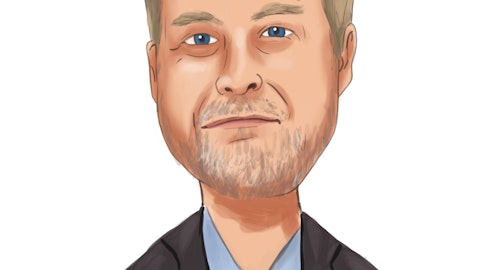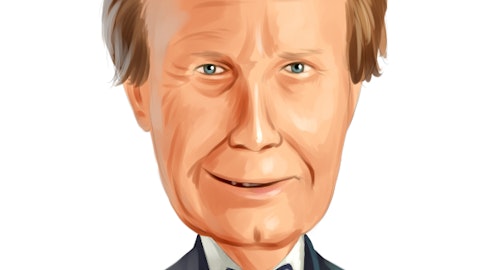MidWestOne Financial Group, Inc. (NASDAQ:MOFG) Q3 2023 Earnings Call Transcript October 27, 2023
Operator: Good morning, ladies and gentlemen, and welcome to the MidWestOne Financial Group Third Quarter 2023 Earnings Call. During today’s presentation, all parties will be in a listen-only mode. Following the presentation, the conference will be open for questions with instructions to follow at that time. As a reminder, this call is being recorded. I would now like to turn the call over to Barry Ray, Chief Financial Officer of MidWestOne Financial Group. Please go ahead.
Barry Ray: Thank you, everyone, for joining us today. We appreciate your participation in our third quarter 2023 earnings conference call. With me here on the call are Chip Reeves, our Chief Executive Officer; Len Devaisher, our President and Chief Operating Officer; and Gary Sims, our Chief Credit Officer. Following the conclusion of today’s conference, a replay of this call will be available on our website. Additionally, a slide deck to complement today’s presentation is also available on the Invest Relations section of our website. Before we begin, Let me remind everyone on the call that this presentation contains forward-looking statements relating to the financial condition, results of operations, and business of MidWestOne Financial Group, Inc.
Forward-looking statements generally include words such as believes, expects, anticipates, and other similar expressions. Actual results could differ materially from those indicated. Among the important factors that could cause actual results to differ materially are interest rates, changes in the mix of the company’s business, competitive pressures, general economic conditions, and the risk factors detailed in the company’s periodic reports and registration statements filed with the Securities and Exchange Commission. MidWestOne Financial Group, Inc. undertakes no obligation to publicly revise or update these forward-looking statements to reflect events or circumstances after the date of presentation. I would now like to turn the call over to Chip.
Charles Reeves: Thank you, Barry, and good morning. On today’s call, I’ll provide an update on the continued progress of our strategic plan execution. Len will then provide an update on our lines of business, and Barry will conclude with a review of our third quarter financial results. As discussed on our first quarter call and outlined on Page 4 of our earnings presentation, we’ve developed a strategic plan with five key pillars. Despite a difficult interest rate environment, which continues to impact our net interest margin, I could not be more pleased with our strategic plan execution as outlined on Slide 5. A key tenet of our strategic plan was a review of our geographic footprint with a focus on improving our scale in attractive markets and accelerating our profitability.
Our September announcement of the sale of our Florida operations with the proceeds reinvested into the acquisition of Denver Bankshares is a significant step towards the realization of our goals. Importantly, this merger accelerates our Denver market growth by three years to four years, while enabling us to more effectively recruit bankers to further accelerate our already attractive growth trajectory. Another pillar of our strategic plan is to expand and move up tier in our commercial banking and wealth management businesses with a focus on our major metro markets of the Twin Cities, Denver, and Metro Iowa. During the third quarter, in addition to the Denver Bankshares announcement, we also made progress in the Twin Cities, having recruited a seasoned banker who led the C&I team for a larger regional bank in this important market.
At MOFG, he will lead our middle market C&I lending team, which is an untapped opportunity and one that we’re focused on further building out as we drive scale in the Twin Cities. We are very excited to be able to attract such a talented lender to lead our middle market team. Treasury management is also a strategic comparative to our C&I up-tiering strategy, and we’ve been investing to expand our talent, platform, and product offerings. Here in the third quarter, we made strong progress as we named a new Director of Treasury Management, combined our sales and service organizations, promoted a team sales leader, and recruited two additional experienced Treasury Management salespeople in our metro markets. Overall, we expect to see a significant improvement in fee income over the next 12 months.
Turning to our wealth management business, our focus has been to build our wealth business through team liftouts, like the recruiting of the wealth teams in the Twin Cities and Cedar Rapids, which has contributed to significant asset growth over the last several years. To further propel this segment, we started an executive search for the leader who will transform our wealth business as we invest and grow the business to the next tier. We’ll also continue to actively recruit wealth management teams in our core markets to drive asset growth and fee income. In our specialty business lines, we hired an experienced agribusiness lending team from a midwestern-based regional bank late in the second quarter. The teams already closed their first relationships and their pipeline has built to more than $40 million.
They’ll be pivotal as we move up market and go after opportunities with larger growers, producers, and suppliers. Government guaranteed lending is also a natural fit for our local and metro bank markets, and our desire is to become one of the leading bank 7A lenders in our footprint. Our 2023 originations have increased by 39%, and we believe we’ll have additional SBA business development officers recruited in the fourth quarter and first quarter of next year. As such, we continue to anticipate this initiative will be a meaningful fee income contributor in 2024 and beyond. Overall, we’ve been very pleased with our success recruiting bankers to MidWestOne and the client relationships that they are generating. As I previewed last quarter, we did expect loan growth to moderate in the third quarter to the mid-single digits, given the general economic outlook and our own selectivity.
Looking forward, we expect to deliver mid-single digit loan growth in the fourth quarter before reaccelerating to high single digit growth in both 2024 and 2025. Turning our focus to improving our operational effectiveness, we outlined a plan to reduce our operating expense base by 5% and then reallocate 2.5% into more productive, profitable markets and departments. I’m very pleased with the initial results of our operating expense review, which can be seen in our third quarter non-interest expense performance. Looking forward, we’ll be reinvesting a portion of these cost saves into people and capabilities to accelerate revenue, while also continuing to look for further expense saves and operational efficiencies. Our focus is to drive excellence across the bank in all facets of our business.
To conclude, we’ve made substantial progress executing our strategic initiatives over the last two quarters as we work to create the foundation to become a high-performing bank that delivers consistent financial results. We’ve accomplished much, while also navigating a very challenging market environment. While we have more to do, I could not be more pleased with the successes that we’ve achieved. Importantly, none of this would be possible without our employees continued commitment to our company, customers and communities, while in the midst of significant change. I’m very proud of their hard work and excited for what the future holds for our team, our customers, and all of our stakeholders. Now I’d like to turn the call over to Len.
Len Devaisher: Thank you, Chip, and good morning, everyone. As I discussed on our second quarter call, our sales teams across the bank have remained focused on retaining and gathering deposits. And the results are showing. We are pleased with the third quarter having generated strong core deposit growth as highlighted on Slide 6. This increase in customer deposits positioned us to reduce higher cost broker deposits. Notably we see consumer deposits stable and commercial deposits increasing, more than offsetting declines in public funds balances. Our commercial banking team is driving strong growth on the asset side of the balance sheet, too. Our nearly $37 million of commercial loan growth in the third quarter was driven by our focus metro markets.
Denver accounted for more than half of the growth and Twin Cities continues to show steady progress. Growth in CRE and ag helped offset a $20 million decline in line utilization. The commercial team also helped our borrowers navigate the current interest rate environment, generating $600,000 of swap income in the quarter. Our loan story is about growth, but also about profitability and soundness. We are pleased that our weighted average coupon of new commercial originations in the third quarter was 7.49%, up from 6.85% in the second quarter. As outlined on Slide 8, our asset quality metrics were impacted by one senior living credit that was moved to non-accrual, which drove the rise in our non-performing assets. That said, our credit risk profile remains solid with low net charge-offs of only 4 basis points and the leading indicator of 30-plus day delinquency at a very low 16 basis point.
As Slide 9 shows, we are well positioned with a diversified loan portfolio without outsized concentration in CRE and only 3.7% in non-owner occupied office exposure. Turning to Slide 10, the talent investments in wealth also continue to bear fruit. Year-to-date, the wealth team has been entrusted with new assets under management of $170 million. As Chip mentioned, we see an opportunity to further grow our wealth business with talent additions at the executive leader and relationship management levels. With that, I’m pleased to turn the call over to our CFO, Barry Ray, to discuss our financial results.
Barry Ray: Thank you, Len. I’ll walk through our financial statements beginning with the balance sheet on Slide 12. Starting with assets, loans increased $47.4 million, or 4.8% annualized from the linked quarter to $4.07 billion. Strength in the third quarter was led by commercial real estate loans, which increased $41.4 million or 8% annualized from the linked quarter. The overall portfolio yield was 5.19%, a 14 basis point improvement from the linked quarter. During the quarter, the allowance for credit losses increased $1.2 million to $51.6 million, or 1.27% of loans held for investment at September 30th. The increase was due to credit loss expense of $1.6 million attributable to organic loan growth. Turning to deposits, our core deposits increased $83.2 million or 1.8% from the linked quarter.
Core deposit growth in the third quarter positioned us to reduce our broker deposits by $145.6 million to $220.1 million at quarter end, as compared to $365.6 million at the end of the second quarter. Taken together, total deposits declined $82.1 million to $5.36 billion at September 30th as compared to June 30th. The rising interest rate environment continued to pressure deposit costs and our total funding costs in the third quarter. Specifically, the cost of interest bearing liabilities rose 35 basis points to 2.33%, comprising of increases to our interest bearing deposits, short-term borrowing, and long-term debt costs. Finishing the balance sheet, total shareholders’ equity experienced an increase of $4.1 million to $505.4 million, driven primarily by third-quarter net income, partially offset by an increase in accumulated other comprehensive loss and dividends paid during the third quarter of 2023.
Turning to the income statement, on Slide 15, net interest income declined $2.4 million in the third quarter to $34.6 million as compared to the linked quarter due primarily to higher funding costs and volumes and lower interest earning asset volumes, partially offset by higher interest earning asset yields. Our tax equivalent net interest margin declined 17 basis points to 2.35% in the third quarter as compared to 2.52% in the linked quarter. Our NIM in the third quarter continued to be impacted by the Federal Reserve’s rising interest rates resulting in an increase in our funding costs, which significantly outpaced the increase of 12 basis points in our total interest earning asset yields. Noninterest income in the third quarter increased $1.1 million, primarily due to a $0.6 million favorable change in loan revenue, coupled with a $0.5 million increase in other revenue.
Finishing with expenses, total noninterest expense in the third quarter was $31.5 million, a decrease of $3.4 million or 9.7% from the length quarter. As Chip discussed, improving our efficiency in operations, including cost reductions, is a key pillar of our strategic plan and our lower expenses in the third quarter reflected our focus on expense management. It’s important to point out that we continue to invest in our business and as a result we expect our run rate non-interest expense to gradually increase going forward. Importantly, we remain on track to reduce our annual expense run rate by approximately $3.25 million with the eventual reallocation of another $3.25 million of our annual expense base into more productive, profitable markets and departments.
Expense control is a key focus of our management team, and we are very pleased with our execution. And with that, I’ll turn it back to the operator to open the line for questions.
Operator: Thank you. [Operator Instructions] Okay, we do have our first question, comes from Terry McEvoy from Stephens. Terry, your line’s now open, please go ahead.
See also 12 Best Places to Retire in Dominican Republic and 15 Best Places to Retire in Japan.
Q&A Session
Follow Midwestone Financial Group Inc. (NASDAQ:MOFG)
Follow Midwestone Financial Group Inc. (NASDAQ:MOFG)
Terence McEvoy: Hi, thanks, good morning. Maybe first off, a question for Barry on the expenses. I was trying to follow along there, but can you help us think about the fourth quarter expense run rate? I know in the third quarter there were some medical insurance benefits that contributed to a bit of a decline. And I guess maybe just clear up a little bit the savings versus the reinvestment and how you think that will actually impact or what expenses will look like?
Barry Ray: Yes, kind of how we’re looking at the fourth quarter Terry is, we expect probably around $32.5 million would be the run rate for the fourth quarter. And as we said in our prepared remarks, when you look into 2024, obviously there’s going to be some typical annual increases. And so we probably get up to the $33.5 million, $34 million range in the beginning of 2024.
Terence McEvoy: Okay, thanks for that. And then sticking on 2024, how should we think about the loan growth comments we heard from Chip earlier? How do we — how are you thinking about the size of the balance sheet overall in terms of growth next year?
Barry Ray: I think — this is Barry, Terry. I think we’ll probably see loan growth of the, let’s call it, mid-single digits.
Charles Reeves: And Terry, this is Chip too. So I think in the loan growth, on my prepared comments, we mentioned reaccelerating to the high single digits. And so, let’s hit the middle of that high mid-single digits and go 8%. We believe that’s very feasible with the originations that we’re seeing and the talent that we are bringing on. Then in terms of our deposit base for 2024, we’ve seen stabilization and some increase here in Q3. And we’re seeing, frankly, the same at the beginning of Q4. So if we extrapolate that, and it’s still a hand-to-hand combat battle on the deposit front. But if we extrapolate that a little bit, we’ll end up 2%, 3% deposit growth in 2024, and then the remaining of the funding of the loan growth will come from the securities cash flow.
Terence McEvoy: Perfect. Okay, maybe one last question. On the first quarter call, you provided some financial targets for the end of 2024 and I believe into 2025. And when I look at the ROA and efficiency, at least in the third quarter, it’s quite a bit of step up to get there and I don’t know if that’s feasible. So Chip, is it really just the interest rate environment and the pressure on net interest income that’s going to keep the ROA below that target or are there some other things that I’m not — I just can’t see as an outsider.
Charles Reeves: No, Terry, I think that’s extremely well said. I’m very pleased in terms of the strategic plan execution that we’ve laid out from April to here in the end of September. I think it’s actually — we’ve probably achieved more in a quicker time frame than even I had laid out previously, especially when you consider the strategic announcements we did at the end of September. The decrease in our non-interest expense run rate as quickly as we’ve been able to achieve such some of that talent hiring. It truly is the movement of the forward curve from where we were in February-March time frame to where we stand today. And as you know, we have a liability sensitive balance feet, so that higher longer is truly about the only reason that those metrics are a little bit off today.
Terence McEvoy: Great. Appreciate it. Have a good weekend, everyone.
Charles Reeves: Thanks, Terry.
Barry Ray: You too.
Operator: [Operator Instructions] Our next question comes from Damon DelMonte from KBW. Damon, your line is now open. Please proceed.




